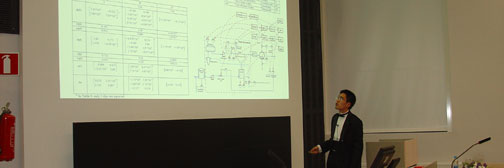| | Year 2001
Kati RönkköOptimising Wet End Chemistry in Wallpaper Base Machine
This Master’s thesis deals with the wet end chemistry of the wallpaper machine PM3 of Kyro Board Mill. It is part of a project that aims to improve the retention of starch by making the chemical conditions more anionic by cutting down on cationic chemicals and raising the pH of circulation water, proportioning pulps and headbox.
In the literature survey part of this study, the main chemicals (starch, rosin size and alum) used in wallpaper making and their functions are introduced. Also, the measurement and control of pH and retention are discussed.
At first the aim was to concentrate on general observation of the chemistry, minimising the process changes and changing the wet end chemistry so that cationic chemicals will react better. pH control of circulation water and the machine chest enabled the pH to be raised in the proportioning pulp and to stabilise the pH changes. It was not possible to raise pH in the headbox when making simplex wallpaper. Due to the coated broke rich in calcium carbonate, the pH rose more easily when making duplex wallpaper. Transferring the proportioning place of anionic starch in use, the desired results were not achieved.
In the next period, attempts were made to raise the pH in the headbox by partly replacing alum with sodium aluminate. The aims were not achieved. However, sodium aluminate seemed to improve the retention of anionic starch. Cationic starch did not have better retention in the trial than the anionic one. The use of fixing agent as affixing pitch and anionic trash did not seem to improve the retention of cationic starch. In summary: it does not seem possible to improve the retention of starches under the conditions of PM3. To reach Cobb targets, a lot of size and alum are proportioned so that the process pH is buffered to 3.8-4.4. Then there are no places on the fibres for cationic chemicals.
Typical retention levels for different paper grades were determined. It seemed that some grades had better retention when there was lower ash content in the headbox or a lower machine speed. Because PM3 is run strictly according to Cobb targets, correlation between retention and sizing was not found. When producing HS grades, larger amounts of alum and rosin size are used causing lower pH and also lower retention than other grades. The implementation of the Kajaani RMi analyser for online measurement of retention was included in the project. Because of the difficulty and unreliability of pH measurements, the main focus should be on equalisation of pH measurements.
Deprecated: strlen(): Passing null to parameter #1 ($string) of type string is deprecated in C:\WWWroot\Root\incs\5_theses\theses_new2010.php on line 248
This info last modified 27 Apr 2024 - contact webmaster
|

